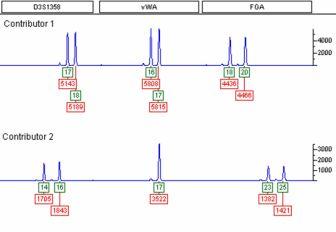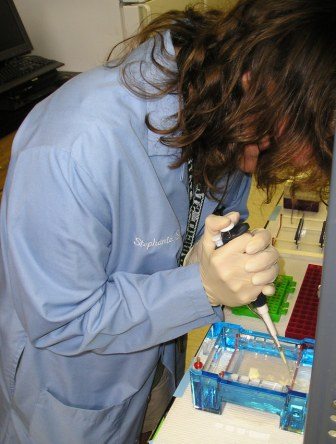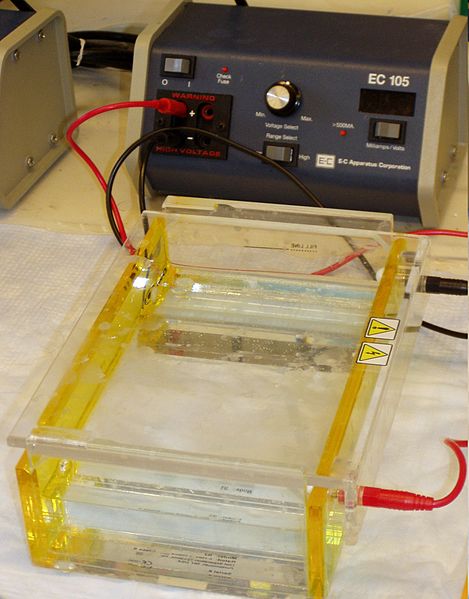Things Writers Should Know About DNA
Sometimes, we just seem to get our tangs all tonguled up and use the wrong words in our stories. Perhaps we learned those incorrect little language units while watching television, or while reading a novel written by a die-hard CSI fan. Either way, here’s some words and facts about DNA that all writers should know if their stories involves this area of forensics.
Terminology
ABI 310 Genetic Analyzer – capillary electrophoresis instrument used in laboratories for DNA testing.
Allele – an alternate form of a gene, such as hair color and the shape of your nose.
ASCLD – American Society of Crime Lab Directors.
Autoradiogram – a sort of x-ray picture of where radioactive probes have adhered to alleles. (It’s a picture of someone’s DNA).
Band – a picture of a DNA fragment.

Capillary Electrophoresis – a method of separating DNA using straw-like capillaries.

The scientist is pointing to the eight capillaries.
Chromosome – a very large piece of DNA.
Males have one Y and one X chromosome. Females have two X chromosomes.
CODIS – Combined DNA Index system. Established in 1998.
Degradation – chemical or physical breakdown of DNA.
Electrophoresis – method of separating DNA molecules using an electric field.
Gel electrophoresis
Electropherogram – A plotted printout of DNA test results.

Gel – medium used in electrophoresis to separate DNA.

Loading DNA into gel.
Genome – an organism’s genetic composition.
Locus – Location of a gene on a chromosome. (pl. Loci)
Mitochondrial DNA – DNA transferred only from mother to child.
STR – repetition of four tandomly repeated nucleotides. The FBI typically uses 13 STR loci in forensic analysis.
DNA Facts:
Identical twins have identical DNA.
Humans are genetically 99.9% identical. Only 0.1% of our genetic makeup is different.
It takes about eight hours for one cell to copy its own DNA.
Red blood cells do not contain DNA.
DNA is used to determine pedigree in livestock.
DNA is used to authenticate wine and caviar.
Detergent and Alcohol will not destroy DNA.
DNA can be transferred from article of clothing to another, even in a washing machine. This is called secondary and tertiary transfer.
DNA testing is not 100% accurate.
Criminal cases involving DNA evidence are usually quite serious in nature (homicide, rape, etc.). Less than 1% of that DNA evidence is reviewed by defense attorneys.
*Want to know what it’s really like to work The Graveyard Shift in a busy police department? Find out tomorrow when romance author/police dispatcher Tracy Seybold stops in for a tell-all visit.







It may not be admissable, Lee, but that won’t stop people from running to the newspaper with the information if they get impatient with the police or want to muddy up the waters. Like you say, yep, it’ll happen.
Dave – I really don’t see how evidence brought in after the release of the crime scene could be admitted as credible evidence. The scene would be contaminated. That’s really no different than someone bringing in a fingerprint and saying they discovered it at the scene, right?
There are plenty of private labs out there that are availble for private DNA testing, but the matter of the crediblitiy of the person who collected the evidence, and where and when it was collected, would still be an issue. Another problem would be the people who had access to the crime scene between the time the police left and the new sample was collected. I just see too many problems.
Let’s see, confusing, problematic, gray areas, more money for attorneys…yep, it’ll happen.
Speaking of private DNA tests, Clair, Lee is right that a citizen could not get evidence from the police to have a test conducted, but I can see a near future when people can run their private tests with material thay have or can get on their own.
Let’s say for instance there is blood left at a scene by a suspect, not all is collected, and the victim’s family can get it and then somehow get DNA from a suspect. A hair sample, for instance. I suppose that if you had the money, you could get the two compared. I can also see defense attorney’s having such tests done.
To show the rapid acceleration of the science of DNA, I believe I saw a news story last week about over-the-counter DNA paternity tests (I believe it was ref. DNA.)
We would be amazed at the capabilities of DNA science if we could see five years into the future.
Hi Clair. No, a private citizen couldn’t get the DNA from the police to run their own tests. That DNA is the prosecution’s evidence in the case. The defense attorney does have access to the test results through discovery, and can challenge that in court. Though they rarely do.
In your case, they might since you’ve mentioned the magic phrase – plenty of money. The software alone that’s needed to open the files provided by crime laboratories can cost in excess of $18,000.00. No, that’s not a typo. Eighteen-thousand dollars for the software alone. Then someone has to read it, etc.
So, would a private citizen with enough money be able to pay for their own DNA testing– for example if the PD was taking too long? Would it be admissable in court?
So many ideas for stories are bred from this site… it’s dangerous. Must be what keeps me coming back. =)
Lee, the only thing I can remember about collecting wet evidence, (usually bloody items,) was that it was allowed to dry before being stored. Otherwise, bacteria could harm the sample. Of course, I think this was pre-DNA and I assume the same rule applies today.
Don’t worry about “outing” me, Lee. I’m old. I know it. But like a good wine, I’m improving with age.
Terry – I won’t mention that Watson and Crick discovered DNA in 1953. Oops. It slipped.
Dave – How detectives handle and store evidence is always important. Things like environments and bacteria will also aid in the degredation of the sample. Forty years ago (even fifteen years ago) police officers simply gathered evidence, stuck it in a bag or box and then tossed the whole thing in their lockers. That was it as far as evidence preservation in many areas. That’s if we even collected blood samples.
How did you guys handle and store wet evidence back in the days before DNA? Prior to the mid-80s.
Scientists have found usuable DNA in plants dating back to 400,000 years ago. The oldest human DNA was from the 100,000 year-old tooth of a Neanderthal found in Belguim.
I believe the oldest known criminal case where DNA was tested is the Jack the Ripper case. That DNA dates back to the late 1800s.
Hi, Lee.
I can remember when DNA on a police report meant “does not apply.”
We had a case a few years back where they tried to run DNA on a 40 year old homicide, but it had degraded too much. I assume the degradation rate depends on how the material is stored and what it was to begin with. Have you ever heard of the oldest case in which DNA was found to be usable?
I’m wondering what might be a reasonable time period for a writer to use DNA to solve and old case.
SweetieZ – The eight hours I was referring to is something that occurs naturally, in the body. Not in a lab.
Isopropyl alcohol can actually be used to extract DNA from cells. So no, it doesn’t harm it in any way.
You can get DNA from clothing. You can also find other trace evidence, such as hair, fibers, semen, saliva, etc.
Dry cleaning won’t destroy DNA. However, it may remove it from the clothing. The same is true for a washing machine, it doesn’t destroy DNA, but it may rinse it away. The DNA will be squeaky clean, too.
Good morning,
Oh so many questions.
Eight hours for one cell to copy its own DNA. Is this a process needed when very little has been given to a lab ?
It seems odd that alcohol does not destroy DNA, does it damage it ?
What can you get from articles of clothing ? And how long could they have been sitting there ?
Does dry cleaning chemicals take from the DNA ?
(Lee, if this is all in your book, just say quiet please ! It is against my religion to make the bed or be subjected to a mall on Sundays. I am also off Wed. / Thurs, this week so will get your book today. Hoo ray !)
TY
SZ
Very interesting, as always. And it makes me feel so OLD because I can remember when Watson & Crick’s double helix was all brand new stuff.
(Is ‘livestack’ a pile of cows? — sorry!)
I thought that photo was Jimmy Durante.
Elena – Are you saying I shouldn’t have used my high school yearbook photo?
Bill – DNA is very, very tough and it “lives” inside cells. Bleach can destroy DNA, but doesn’t always degrade it down to individual nucleotides, which wouldn’t be testable. It really takes a lot of the chemical to totally beat forensic DNA dyes. Some scientists use bleach to wipe down their workstations between DNA tests to prevent cross-contamination and sample mixtures.
The thing to remember is that a lot of times police detectives collect their own evidence, and many of them aren’t suffiently trained to properly care for, and handle, DNA evidence. Therefore, they may package the sample incorrectly. For example, evidence that’s to be tested for DNA should never be packaged in plastic because plastic is a breeding ground for bacteria, and bacteria can and does degrade DNA.
Okay, but what WILL destroy DNA?
And, man, caviar and wine? That is soooo cool.
Scanning quickly to get the gist of today’s learned discourse, I found myself saying, “Oh, that’s what a crime lab director looks like”. Three photos later, I came to, went back, and caught up with myself 🙂
Excellent overview, I especially appreciated the DNA Facts – interesting info.